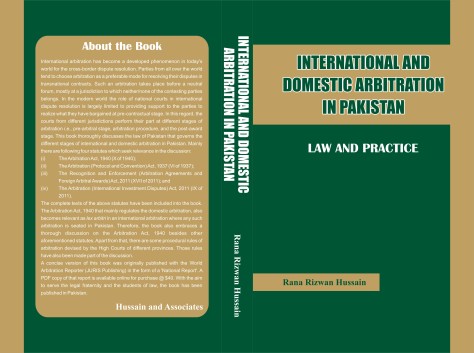
The book ‘International and Domestic Arbitration in Pakistan’ by Rana Rizwan Hussain discusses the law and practice of arbitration in Pakistan that has developed over the years. Starting with an overview of arbitration practice in Pakistan, it talks about the different stages of it i.e., pre-arbitral stage, arbitration procedure, and post-arbitral stage. The discussion entailed in the book is mainly based on the statutory provisions and the case law. Moreover, the scholarly opinions have been added to furnish off the remaining gaps. It comprehends the domestic and the international arbitration practice of Pakistan.
After defining arbitration and discussing its nature, it provides an overview of arbitration in Pakistan and analyses the pre-arbitral stage. Thereafter, it moves to the arbitration procedure and elucidates the mode of conduct of domestic and international arbitrations. It also brings into study, the relationship between the arbitral tribunal and the court, both in international and domestic contexts. It defines the role of a national court in international arbitration proceedings. Thereafter, it explains the validity of different types of awards and enumerates the post-award stages. It also talks about the after-award proceedings including enforcement, appeal, and annulment actions. In this regard, this book comprehensively discusses the domestic and foreign awards, further distinguishing between foreign commercial and investment awards.
The book explains that after implementing the 1958 New York Convention in 2005 and the 1965 ICSID Convention in 2006, Pakistan is still struggling to harmonise its arbitral practices with international ones. There are many areas of arbitration law that remain to be un-addressed in Pakistan both in the statutes and the case law. In order to fill up that gap, the book refers case law from other New York Convention jurisdictions and relies upon the treatises of distinguished authors across the world. Its purpose is to enlighten the reader of the positions taken by the courts in the developed jurisdictions and international arbitration experts on those issues, which have not yet been attended in Pakistan. With regard to domestic arbitration practice, various references have been made to the Judgments from Indian jurisdiction. It is because the Arbitration Act, 1940 (X of 1940) had been in force in India until 1996 when it was repealed by the Indian Arbitration and Conciliation Act, 1996 (Act XXVI of 1996). Sharing a common legal background with Indian jurisdiction, the Judgments by the Indian courts on the repealed law are still taken to be of great persuasive value in Pakistan. The said rulings fill up the gap that remains to be there in Pakistani case law.
The book reveals that a concise version of it was initially published with the World Arbitration Reporter (JURIS Publishing) in the form of a National Report in 2015. Several improvements have been made into it by way of adding conceptual study and latest Pakistani cases after its publication with World Arbitration Reporter. A chapter on the public policy of Pakistan has been included and the grounds for refusal of enforcement of foreign awards under the New York Convention have been discussed with the help of foreign case law and juristic viewpoints. Statutory texts of laws and rules governing arbitral process in Pakistan have also been added as appendices.
This book is a high quality manuscript which is an update to the international arbitral community of the existing law and practice of arbitration in Pakistan. Moreover, it bears all the characteristics of a textbook on arbitration for the students and the practising lawyers in Pakistan.
Email: – ranarizwanhussain@gmail.com



